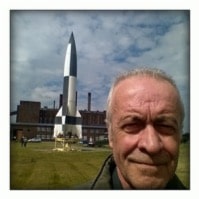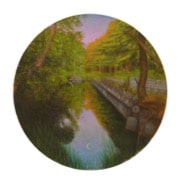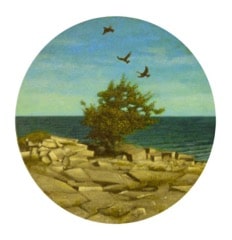A Walk on the Wild Side
PICTURES FROM PEENEMÜNDE
JAMES MCDONALD, 2018

I first travelled to Peenemünde in June of last year and soon developed a near-fixation with the place, making a further two journeys over the next couple of months. Situated at the Northern tip of Usedom, an island straddling the German/Polish border, Peenemünde is known mainly for its association with Germany’s development of rocket technology in the thirties and forties, specifically, Wernher Von Braun’s Vergeltungswaffen or “Vengeance Weapons”. If there were an award for most colourful and unlikely career of the 20th Century, then Wernher Magnus Maximilian Freiherr Von Braun would surely have been a strong contender; from a childhood hobby of building rocket-propelled cars, this descendant of Scotland’s King Robert III and England’s Edward III went from designing the V2 missile for Hitler to designing the Saturn V rocket for NASA, (which, ultimately carried astronauts to the moon), while working on Children’s Television for Walt Disney. Initially, though, I was intrigued by photographs I had come across of the now abandoned Sauerstoffwerk, the liquid oxygen factory in the centre of Peenemünde village itself. Built in the thirties to produce fuel for the missiles, I had a notion of making some grand watercolour view of its concrete-vaulted, crumbling and ivy-strewn interior; perhaps in the manner of Van Steenuigck or Johann Morgenstern. As it turned out, this haunting island had much, much more to offer.
Although some worthy local and state efforts have been made to attract visitors here, Peenemünde is still, thankfully, somewhat beyond the beaten tourist track, although for a non-driving visitor such as myself, it is actually easier and quicker to reach than, say, John O’Groats! A two-hour flight to Berlin, followed by a most agreeable train journey north, taking less than five hours. There are a few well-timed changes on this route, before the final train takes you from Zinnowitz, via the old single-track military railway to the heart of this now sleepy harbour village.
On my first trip I enjoyed the luxury of a hotel, the “Garni Zur Zwiebel”, arriving there around 7.30 in the evening and being warmly greeted by the proprietor over a refreshing bottle of complimentary beer. His answer to my query regarding access to the oxygen factory at the end of his street, though, was disappointingly curt: “There is no access”….
“Access”, as it turned out, would be a problem on this and future visits. In its years as a secret military research facility, the northern half of the island was annexed. The Red Army took over – peremptorily shooting the camp commander and his wife in April 1945 and this situation continued under the national Volksarmee until 1955, when partial access was allowed. Even now – and for good reason – most of the northern half is fenced off and given over to nature. Be prepared to crawl under electrified wires and over or through high fences!
On arrival in Peenemünde, the first thing you see, dominating the harbour, is the Kraftwerk – a once state of the art, coal-fired power station, built to power the factory and the military research and development facilities to the North and East of the island at Karlshagen. Now a technical Museum specialising in the history of space exploration, I marvelled at its scale and at the Aggregat 4/V2 rocket in its geometric black and white test-livery, standing at its entrance, silhouetted against a lovely sunset. Nearby stands a V1 flying bomb (Doodlebug), on its metal-railed launch ramp.
Wandering down to the harbour, I relaxed with a cigarette and watched as the sun dipped below a decommissioned missile-launch capable submarine, its empty tubes pointing skywards. Tourist literature describes this as a “U-Boat”, but the large red star on its hull gives it away as being of Soviet vintage. Of night life, there is practically none – the quayside Indian-owned Italian restaurant closes around eight o’clock – though I would definitely recommend the old wooden yacht moored next to the submarine. If you have sea legs, a taste for excellent beer and 1920’s German dance band recordings of vintage hits such as, “California Here I Come”, and, “It’s A Long Way To Tipperary”, then you will feel very much at home here!
THE LIQUID OXYGEN FACTORY

As it turned out, getting into the oxygen factory wasn’t too difficult. Rising before dawn, I made my way along the deserted street and sure enough found a small gap in the wire fencing. Negotiating some collapsed masonry, I eventually found myself in the long, high-ceilinged entrance hall just as the sun crept over the horizon. There is nothing much left here by way of machinery, most of it having been stripped and shipped east to Russia at the war’s end, but what remains is breathtaking. Echoing with birdsong, low sunlight dappling raw concrete and shattered plaster walls in bright, flickering shadows, it is reminiscent of some vast, Brutalist cathedral.
All around, chambers lead onto chambers at crazy angles, concrete vaulted naves choked with shrubs and trees and high, smashed “transept” windows, where a rosy dawn glow forms in the west. The place is silent as I explore, save for the birdsong and the sound of my footsteps in rubble. Once, fortified by a visit to the yacht, I returned here after midnight, but I wouldn’t really recommend this – there are unexpected spaces underfoot here and there, plunging a level or two down into the even darker basements.
RUINS OF THE MISSILE STORAGE BUNKERS AT CAMMERER-SEE

Later, a bracing walk along the dyke, south from Peenemünde to the Cammerer-See found me in picturesque fields full of missile storage bunkers spread out over a large area. Under the Potsdam Agreement, an effort was made to blow them up in 1948, but with structures of this density that proved almost impossible. Like ruined mausolea in the sunlight, all broken concrete columns and arches, they now provide an almost Italianate, classical prospect; sheep grazing peacefully nearby add an oddly pastoral quality to the scene. At night it is a different matter – stranded, I once had to shelter until the dawn in one of them – with two sand martens for company flitting in and out and hovering outside their nest above my head, as the most ferocious electrical storm I have ever seen, crashed in from the sea, broiling and crackling in the intense darkness around me. Worried at the proximity of the lightning bolts, I at first looked to my Blackberry for advice on, “what to do if caught exposed in a thunderstorm?” To which the answer came, “First, switch off your phone immediately …”.
PRÜFSTAND VII

In the forests and on the coast of the island from Karlshagen in the south, to the military airfield on its northern tip are a series of missile launch sites, Prüfstands, all linked by a straight, concrete road built in the thirties. After my first trip, I researched these sites further, in particular, “Prüfstand VII”. My host at “Zur Zwiebel”, had warned me off this one in particular, but had eventually relented and drew me a small map suggesting the most expeditious – and discreet – route there. This involved entering the forest from the beach and following a little-used path, in the middle of the night.
“WILD-camping”, or sleeping rough is strictly forbidden in Germany and is disapproved of in most of Western Europe – though, oddly, it is practically encouraged in Estonia. This I learned, while making arrangements to do just that, for my excursions to the uninhabited forests to the north. I purchased a 2 x 3 metre camouflage tarpaulin and sought out instructions on erecting a “tarp-shelter” using just three pegs and a shoulder-high pole of either lightweight aluminium or wood. In my studio, I rehearsed the simple, origami-like procedure rigorously, using a scale model consisting of chopped-up shirt, a sawn-off pencil (corresponding to “shoulder-height”) and three staples, assembling the mini-shelter sturdily to my work bench. Simple – an idiot could do this! The reality, however, is a wee bit different “in the field”.
Arriving late and exhausted at my chosen spot, just off the beach at the edge of the forest, clearing a space on the grassy and sloping ground took ages in the darkness. Even when assembled, the whole contraption fell down on me twice, panicking me briefly me briefly as I struggled to escape its pitch-black clutches. Trying to sleep was pretty pointless, as even with my jacket hood up over my skip cap I kept hearing things – large and small rustlings from outside in the forest and from below my pound-shop groundsheet, miniscule, creepy movements , too close to my ear.
After illuminating a tiny, cerulean-blue snail with my wind-up torch (too close to my face), I gave up and sat on the beach for a while, in a sparkling haze of fireflies, before entering the forest around 2.00 am.
First spotted by an RAF reconnaissance Spitfire in May, 1942, Prüfstand VII is a large oval-shaped earthwork where static test-firings of the Aggregat 4 rocket – later, V2 Missile – were conducted. It is also where the first successful launch of a man-made object into space was made, in 1942. The Germans missed an opportunity here, I feel; in 1947, the Americans fitted a camera to one of the hundred-odd V2s they acquired after the war, and recorded the first images from space during a launch from their White Sands facility. Later, in August 1943, Operation Hydra was conducted by the RAF. The biggest single British bombing raid of the war saw 600 bombers engaged in attacking the place over one long night. Reconnaissance photos from the time show a blasted and cratered surface reminiscent of the Moon. Damage was severe, but, ultimately, ineffective. Deviously, many of the bombs were fitted with time-delay switches to hinder repair work, which explains the plethora of signs all along this now fenced-off restricted zone proclaiming, “MUNITIONSBELASTETES GEBIET LEBENSGEFAHR BETRETEN UND BEFAHREN VERBOTEN!” Not knowing of “Hydra” on my first visit here and (though obviously a warning) not being in possession of a German/English phrasebook, I had idiotically assumed these signs were just for show … I eventually find a hole in the wire fencing and after a while manage to find the military road northwards. After a long walk in darkness, flanked by deep pine forest, I arrive at Prüfstand VII just as light is appearing in the east.
The heavily wooded and overgrown amphitheatre that is now Prüfstand VII is a genuinely strange and poignant place. What was once a place of bustling, pyrotechnic activity lies silent and abandoned to nature. Although it is forbidden to visit, a small cairn nestles among pine cones at the original launch site and, in the hour before dawn, is eerily silent. Once, when I visited, there was a wee posy of flowers laid here.

The central, reinforced concrete “flame-pit”, and its accompanying cooling-channels, where once static test-firings and launches spat fire, are now long-flooded, their still waters like three short canals going nowhere. On their surfaces, a fading crescent moon is reflected, as the Sun eases itself above the treeline behind me.
EARLY MORNING DIP BY THE V1 LAUNCH RAMPS

Having enjoyed a satisfying, if Spartan, breakfast of dry bread and schnapps at the head of the flame pit, I decide to enter the forest-proper, eschewing paths and pointing myself in the general direction of the V1 launch ramps nearby at the very Northerly tip of the island. Now officially a nature reserve, this forest is rich in wildlife. Too rich for my taste, to be honest.
There are thirty pairs of sea eagles on the island and what seems to be thousands of large black geese. They perch high in the trees and their nesting area shows up as a large defoliated chunk of white forest on the satellite imagery. Once, while lost, I had the misfortune of stumbling upon this unpleasant area; raucous, airless, bare-branches and forest floor covered in what appears to be ash, but is actually accumulated bird waste. A giant, unseen eagle clattering low through these trees above my head here might as well be a pterodactyl …
There are snakes; black and rustling as they slither through the dried leaves of the forest floor, mosquitoes and tiny black parasitic spiders which, even with a liberal application of magnesium sulphate, take some dislodging. What really gave me a start though, was stumbling across a group of wolves in a sunlit clearing. I have rarely been so frozen with fear and it was quite a relief on seeing their tusks, as one turned to regard me curiously, to realise that they were only wild boar. Wild Boar … my mind did a quick retrieval on what little it knew of them – “low centre of gravity … wild, genital injuries, omnivorous, wild” … finally a solitary large sign in my head bearing a name materialises … “MASON VERGER”.
Gingerly, trying not to give any appearance of panic, I walk backwards and sideways, into the trees as far from them as possible.
There are old bomb craters everywhere in the woods and it is a relief to reach an oak-lined path and smell the sea-air. It is still only mid-morning and the bright Baltic Sea stretches before me. A low, concrete pill box stands at the entrance to the Startplatz. Paved in hard, white concrete, there are the overgrown remains of five launch ramps each pointing in different directions, though the largest ramp points over the bay to an islet where once a manned telemetric point would measure the V1’s speed and progress. There are ruined bunkers here and there, and in the bright sunshine and impossibly blue sky this place takes on a surreal air. The military airfield is just over a fence to the west where a windsock hangs limply, but there is not a soul to be seen or heard. I recollect a memorial at the Technical Museum celebrating a remarkable escape by Russian prisoners in the closing months of the war – eight of them had managed to fly home from here in a stolen Heinkel bomber. Relaxing on a shattered bunker roof, my reverie is briefly disturbed by the largest badger in the world sniffing the air curiously, before shuffling past me. Copper coloured cattle graze in a field to the west. Overhead, there is a ceaseless coming and going of black geese from the forest to the sea, flapping in V-shaped formations. Going fishing …
Tired and sporting a subtle bouquet of sweat, fading panic and stale pound-shop mosquito repellent, those sparkling blue waters look very tempting and I decide to go for a morning dip myself. Naturism has never really been my bag, but what the hell – there is no one around for miles! The nearest boat is far off on the hazy horizon, near Prora. Rolling under an electrified wire, I stroll down to my thin strip of white sandy beach at the end of the main ramp and , disrobing, lay out an imaginary towel on a non-existent deckchair …
JAMES McDONALD, 2018

